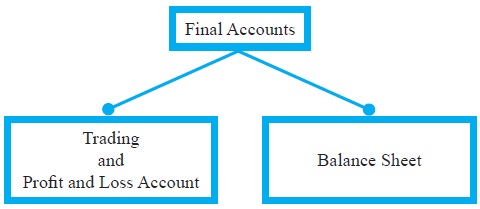Accountancy - Introduction to final accounts | 11th Accountancy : Chapter 12 : Final Accounts of Sole Proprietors - I
Chapter: 11th Accountancy : Chapter 12 : Final Accounts of Sole Proprietors - I
Introduction to final accounts
Introduction to final accounts
Business entities raise funds, acquire assets and incur various expenses
for the purpose of carrying on business operations and earning income from such
operations. These transactions are first recorded in the journal and then
classified under common heads in the ledger. Preparation of trial balance from ledger
balances helps to verify the arithmetical accuracy of entries made in the books
of accounts, but it is not the end in itself. The business entities are
interested in knowing periodically the results of business operations carried
on and the financial soundness of the business. In other words, they want to
know the profitability and the financial position of the business. These can be
ascertained by preparing the final accounts or financial statements. The final
accounts are usually prepared at the end of the accounting period on the basis
of balances of ledger accounts shown by the trial balance.

The final accounts or financial statements include the following:
i.
Income
Statement or Trading and Profit and Loss Account and
ii.
Position
Statement or Balance Sheet.
The purposes of preparing the
financial statements are:
i.
To
ascertain the financial performance of an enterprise and
ii.
To
ascertain the financial position of an enterprise.
The income statement and balance sheet are prepared for these purposes
respectively. Income statement gives the manner in which the profit or loss for
an accounting period is arrived at. The revenues earned and expenses incurred
to earn the revenues during the period are shown in the income statement under
appropriate heads as per matching principle. All the nominal accounts and
accounts relating to goods during an accounting period are to be considered
only in the relevant accounting period and are not to be carried forward.
Moreover, only these items are to be compared for determining the financial
performance. Hence, at the close of the accounting period, all nominal accounts
(i.e. expenses, losses, revenues, gains, purchases, purchases returns, sales
and sales returns) are to be closed by transferring to the income statement or
trading and profit and loss account.
While transferring the items, it is desirable that the results of buying
and selling of goods and the results of overall operations and financial
performance are given separately. Hence, income statement is divided into two
parts. The first part, i.e., trading account shows the results of buying and
selling and the second part shows the results of overall financial performance.
The second part may also be presented in such a manner to give the operating
results and overall financial performance separately. All the direct expenses
and items relating to goods are transferred to trading account which is the
first part of income statement. All indirect expenses and losses and indirect
incomes and gains are transferred to profit and loss account along with the net
result of trading account.
Related Topics